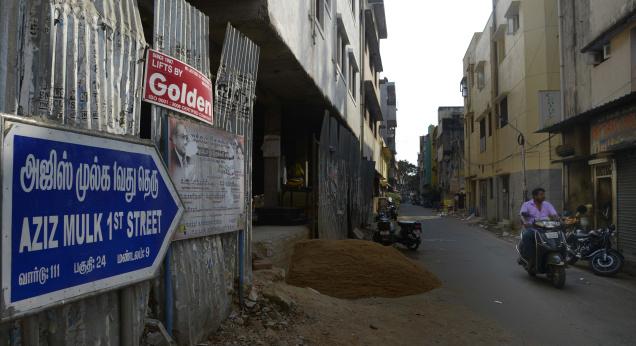Madras (now Chennai), TAMIL NADU :

Just beyond the Gemini flyover, Model School Road, Anna Salai and Graeme’s Road enclose a perfect rabbit’s warren of streets. There are nine of them, and they all take their name from Aziz Ul Mulk, a Muslim nobleman who once owned the entire area.
This was known as Aziz Baugh till the early 20th Century and was most likely more of a garden than the residence of the owner. When Sir William Thomas Denison, Governor of Madras, was leaving the city in 1866, he, his wife and daughter were invited for a farewell hosted by the Muslims at the ‘Gardens of Azeez Ool Moolk Bahadoor, Graemes Road, at 7 1/2 pm, on Saturday, the 24th of March’.
‘An evening entertainment in the gardens of a man bearing such a name!’ enthused Denison in his diary. He expected something out of the Arabian Nights and was not disappointed. The first family alighted in front of a wide, open verandah that was brilliantly lit, the brightness being enhanced by ‘suspended globular mirrors’. The hosts, all clad in white but sporting red turbans and sashes, stood on either side of the steps and ushered the guests to sofas at the rear of the verandah. A formal address was presented.
Dinner was in a shamiana to the side of this pavilion and ‘old Azeez Ool Moolk’ led Lady Denison to it, while the Governor was escorted by Nazim Jung, his son ‘who is an active intriguing man, a sort of politician in his way, and the presiding genius of the present entertainment’. Dinner was served in European style and described as a ‘tedious affair’ in which the English found much to their amazement that the hosts ate nothing but a ‘biscuit and some fruit’. Thereafter, the group moved to another shamiana where a nautch was presented.
‘Eight dancing girls, all dressed alike, stood in the centre of the apartment, each holding one of a cluster of eight ropes, which were suspended from the ceiling; and then with a slow and graceful movement passed to and fro, in and out, in such a manner as, by this movement only, to twist the eight ropes into a regular plait through their whole length, and then to untwist them, the whole being done by the dance only, without the application of the hands’. We would recognise this today as pinnal kolattam.
All this gaiety hid the fact that Aziz Ul Mulk was heavily indebted, mortgaging much of his valuables with the bank of Girdar Das Vallaba Das. Like the aristocrat in Satyajit Ray’s Jalsaghar, he was clearly spending his money on entertainment he could ill afford. Aziz Ul Mulk’s death is not recorded, but by 1868, the intriguing son — Sumsaum Ud Dowlah Bahadur aka Nazim Jung — was dead. The family finances must have declined thereafter, for, by 1902, we find the area recognised as a slum. Certainly, there is no trace of the garden where a Governor once dined.
source: http://www.thehindu.com / The Hindu / Home> Features> MetroPlus> Hidden Histories / by Sriram V / Chennai – April 08th, 2016








